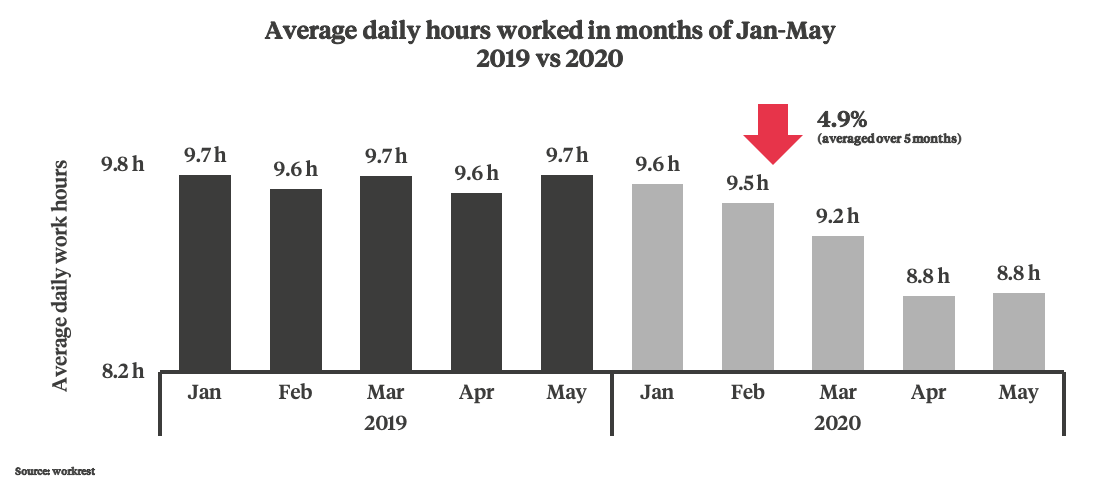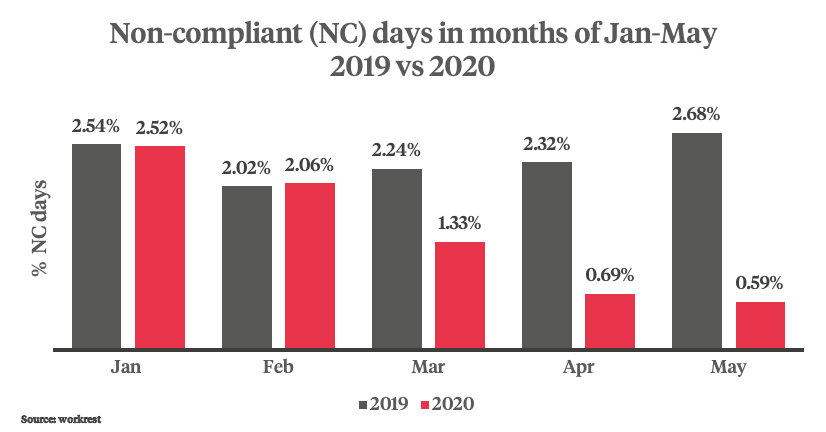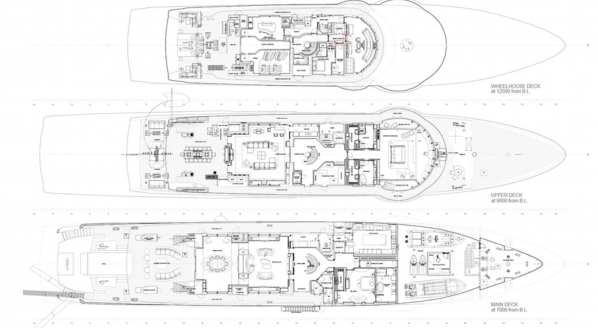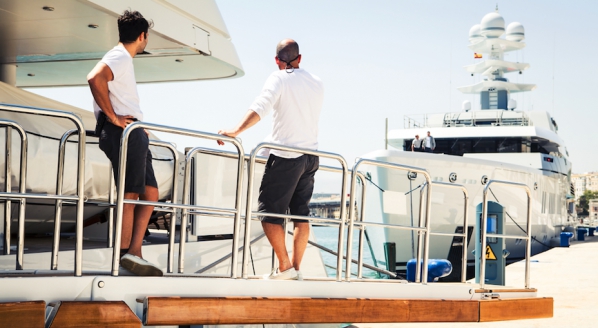COVID-19 impacts crew working hours
Data provided by workrest confirms that crew have worked less hours over the course of the pandemic…
At the time of year when most superyachts would be getting ready for a busy season and setting off on the first trips of the summer, the COVID-19 outbreak saw strict lockdowns enforced worldwide and, as such, the majority of superyachts have been reportedly tied up on the dock instead. It makes sense, then, that the crew on board – who typically have to work longer hours during guest trips – would be working less hours than would be normal for this time of year.
To help understand whether this has actually been the case, SuperyachtNews partnered with workrest to get insight into the working patterns of up to 5000 crewmembers who logged over half a million days between the months of January and May in 2019 and 2020. “As we’re coming into what would traditionally be one of the busiest times of the year, we’re seeing a dramatically different picture in working hour schedules caused by the uncertainty of when or if the summer season will begin this year,” explains Stuart Willis, CMO at workrest.
The below graphic shows the average crew daily working hours logged on workrest (on working days only) between January and May in 2019 versus 2020. While there is little difference in the hours worked in the months of January and February when comparing this year and last, there are is a significant reduction in hours for the months of March, April and May 2020 – during which time the pandemic had its biggest impact on travel around the world.

In March 2020, average daily working hours dropped by 0.4 hours compared to the same month in 2019 and, in May 2020, average daily working hours dropped by 0.9 hours compared to the same month in 2019. The change in average daily work hours shifted from a nominal 0.8 per cent reduction in January 2020 (versus January 2019), to a significant 9.3 per cent reduction in May 2020 (versus May 2019). This clearly shows that the effects of the pandemic translated into a reduction in average daily working hours for crew in March, April and May 2020, due to fewer guest trips taking place compared to the same time period in 2019.
By tracking crew working hours on board, workrest also tracks compliance and non-compliance with the Maritime Labour Convention (MLC)’s requirements for hours of work and hours of rest. During peak season, the crew sector often bemoans the challenge of staying compliant with these requirements, due to the demanding workload required of them during guest trips. The graphic below shows data provided by workrest regarding the number of non-compliant days that occurred over the January-to-May period in 2019 versus 2020.

Following the same trend, the data shows that less non-compliant days were recorded by crew in the months of March, April and May in 2020 compared to 2019. As a percentage of total days worked, workrest normally logs about two-to-three per cent as non-compliant days, and this percentage then goes up during the summer months. However, 2020 has seen the percentage of non-compliant days fall each month, to 0.59 per cent in May, which is well below what is normal for this time of year.
Both datasets, showing crew average daily working hours and non-compliant days in 2019 versus 2020, provide insight into how yachts have been used during the peak of the pandemic. With anecdotal reports of yachts both sat idle on the dock and with owners and guests quarantining on board, the data suggests that the overall trend is that yachts have been more inactive than usual for this time of year, meaning reduced working hours for crew and greater compliance with MLC requirements.
It appears that it takes a pandemic and, as a result, owners and guests unable to get on board their yachts, to allow crew to work at a more normal intensity level (just under nine hours per day) and increase the industry's compliance with regulations that are intended to protect crew welfare. This serves as an important reminder that many yachts are not operating with appropriate manning levels to enable crew to keep to reasonable working hours when owners and guests are on board.
Workrest provides crew management software designed to simplify hours of rest and leave management on board.
Profile links
NEW: Sign up for SuperyachtNewsweek!
Get the latest weekly news, in-depth reports, intelligence, and strategic insights, delivered directly from The Superyacht Group's editors and market analysts.
Stay at the forefront of the superyacht industry with SuperyachtNewsweek
Click here to become part of The Superyacht Group community, and join us in our mission to make this industry accessible to all, and prosperous for the long-term. We are offering access to the superyacht industry’s most comprehensive and longstanding archive of business-critical information, as well as a comprehensive, real-time superyacht fleet database, for just £10 per month, because we are One Industry with One Mission. Sign up here.
Related news

Operating safely in the new normal
ABS Group has developed a risk management model to aid yachts in the COVID-19 environment
Business

Effects of COVID-19 felt by recruitment sector
Crew agents discuss the impact of the pandemic on recruitment and what this signals for the season ahead
Crew

How is COVID-19 affecting crew employment?
Quay Crew undertook a survey to understand whether crew positions are in jeopardy due to the pandemic
Crew
.jpg)
SuperyachtNews COVID-19 Advisory - optimising crew downtime
UKSA's Chris Frisby on how crewmembers can use time aboard inactive yachts to enhance their careers
Crew
Related news
Operating safely in the new normal
6 years ago
Effects of COVID-19 felt by recruitment sector
6 years ago
How is COVID-19 affecting crew employment?
6 years ago
NEW: Sign up for
SuperyachtNewsweek!
Get the latest weekly news, in-depth reports, intelligence, and strategic insights, delivered directly from The Superyacht Group's editors and market analysts.
Stay at the forefront of the superyacht industry with SuperyachtNewsweek



